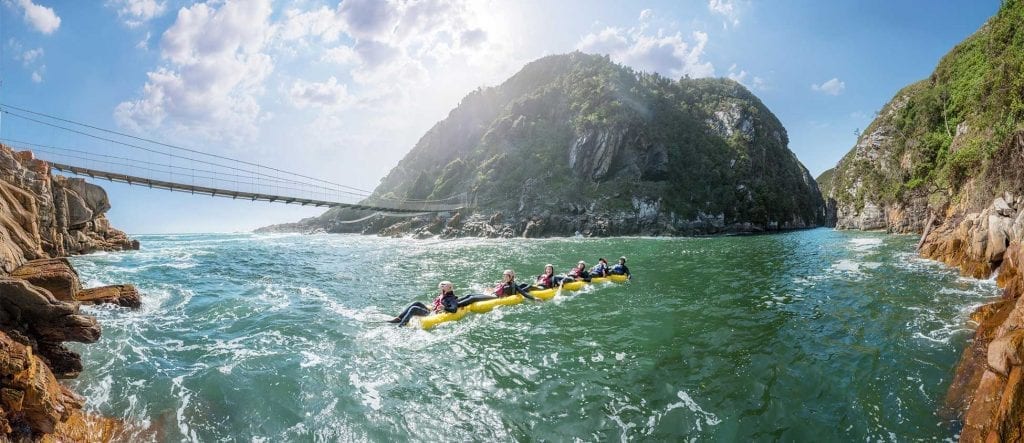
Accommodation: Country lodges and hotels
Activities: Diving, snorkelling, kayaking, hiking, swimming, climbing, abseiling, mountain biking, sailing, bungee jumping
Highlights: Famous Otters and Dolphin trails, scenery and whale watching
Tsitsikamma National Park is a multi-dimensional destination with dramatic coastal scenery, reefs, rivers, lush forest and delicate Fynbos. A hiking and water sports paradise, this region forms the top section of the magnificent Garden Route National Park.
In Tsitsikamma National Park, Garden Route, South Africa visitors will see booming breakers of the Indian Ocean relentlessly pound rocky shores, temperate high forest and Fynbos (indigenous plants) rolling down to the sea in an unspoilt verdant carpet. Age old rivers carve their way to the sea and wonderful marine creatures swim along the shore.
The boundary of the Tsitsikamma National Park, South Africa stretches some 5km (3 miles) out to sea, protecting a wonderland of inter-tidal life, reef and deep-sea fish. Beautiful Dolphins play and surf in the breakers. The Southern Right Whale visits these waters in season, coming inshore to breed. The park has two rest camps, one at Storms River mouth and one at Natures Valley.
There are many hiking trails of varying lengths and nature walks in this region, the most famous of them being the Otter Trail, one of the best in the world. For those who prefer not to rough it there is a “slack packing” route, the Dolphin Trail, which is fully inclusive and includes portage.
The Otter Trail starts at the Storms River camp and the South African National Parks has laid out several short trails for day visitors. Set in the Garden Route, the trails lead through coastal and forest scenes, as well as various waterfalls, streams and rivers.
l. The Suspension Bridge and Lookout Trail is an easy stroll that leads along the western side of the river mouth, past the Strandloper Cave to the suspension bridge across the mouth. On the other side of the bridge there is a short but very steep climb to a lookout point from which there are fine views of the mouth and the camp.
2. The Waterfall Trail is a short but demanding hike which follows the first 2.65 kilometres (1.65 miles) of the Otter Trail; hikers may not walk beyond the waterfall unless hiking the Otter Trail.
3. The Blue Duiker Trail starts just west of the information centre and leads through scrub forest tip to the Agulhas lookout from where whales and dolphins can often be spotted in winter. After crossing a short section of fynbos, the trail takes hikers into the dry forest with some fine Sickle-leaved Yellowwoods evident.
The Blue Duiker Trail continues through the forest, crossing a stream below a delightful waterfall. Several more streams and a cavernous tree bole mark the route. After crossing the road to the camp, the path drops to the coast just west of the start of the Waterfall/Otter trails and returns past the camp site and chalets. Birdlife unique to the forest is found west of the road, which makes this trail a favorite with birdwatchers.
4. The Lourie Trail is a short-cut to the Blue Duiker Trail, marked with the yellow sign. This trail passes next to a waterfall and has gorgeous views over the marine reserve. During the whale period, and if the sea is calm, whales can often be seen from the top of the cliffs.

The Tsitsikamma Marine Protected Area is situated along the shoreline of the park, and provides protection for marine habitat and wildlife, including birds and threatened and endangered fish species. It is one of the largest and oldest restricted (no-take) MPAs in the world.
The location is in near pristine condition, and is thus suitable as a suitable area for research on endangered fish species. It was designated as a Marine Protected Area in 1964.
The length of the protected shoreline is 60 km, and the area of protected ocean is 186 km2.
The MPA is also managed by SANParks.